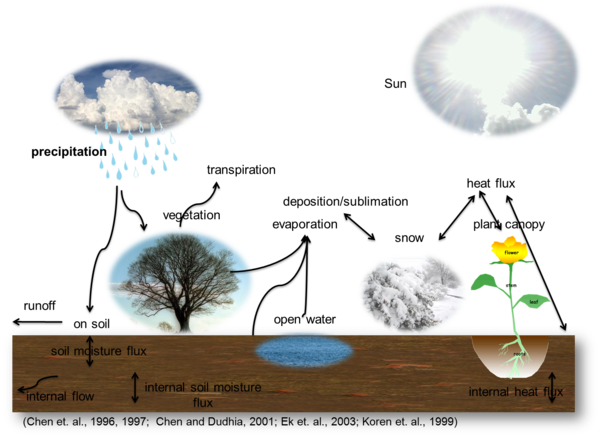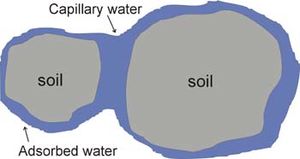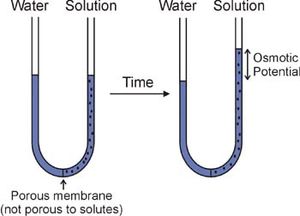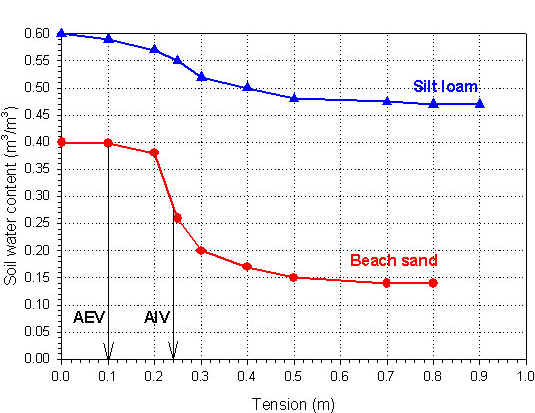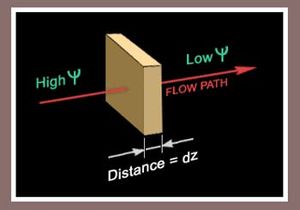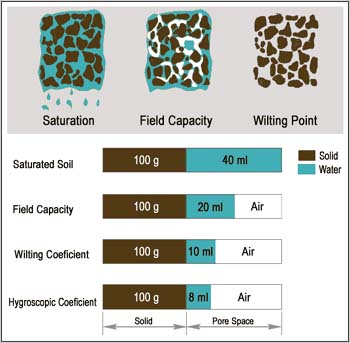LFS:SoilWeb/Soil Components/Soil Water
Water is the major transport agent for fluxes within and between terrestrial ecosystems. It is a prerequisite for all active life, and participates in geochemical cycles by weathering geological substrates, by leaching materials to groundwater and by moving ions and particles through the soil profile.
Soil water is part of the global hydrological cycle, which shows how water that falls as precipitation returns to the atmosphere through transpiration and evaporation. On a local scale, how well the soil stores water is of great importance to crop production and the vitality of the land.
The Hydrological Cycle
Percolation is the downward movement of water through soil; specifically, the downward flow of water in saturated or nearly saturated soil.
Runoff is the portion of the total precipitation on an area that flows away through stream channels. Surface runoff does not enter the soil. Groundwater runoff or seepage flow from groundwater enters the soil before reaching the stream.
Evapotranspiration is the loss of water from a given area during a specified time by evaporation from the soil surface and by transpiration from the plants.
Water and air constantly compete for pore space in soils. Most of the time soil pores are not full of water, but occasionally (after heavy storms or in swamps and bogs) some soils may be saturated with water and little or no air is present in pores.
Soil Water Content
Water content is the quantity of water contained in a soil. The diagram below illustrates soil composition by phase, allowing us to define terms which are generally used to express the quantitative interrelations of the three soil phases.
Soil composition by phase: V = volume, while M = mass. s = solid, v = void (pores), w = water, a = air, t = total (volume or mass):
Soil water content on a volume basis (θv = volumetric water) is the ratio of water volume (Vw) to total soil volume (Vt):
- θv = Vw / Vt or
- θv = Vw / (Vs + Vf)
- Vs = volume of solids; Vf = volume of pores
Soil water content on a mass basis (θg = gravimetric water) is the ratio of mass of water (Mw) to mass of soil solids (Mt):
- θg = Mw / Mt
RELATED LINK:
|
Soil Solution
Soil solution is the aqueous liquid phase of the soil and its solutes (dissociated ions). Nutrients occur in the soil solution mostly as ions:
NH4+, NO3-, H2PO4-, HPO42-, K+, Ca2+, Mg2+, SO42-, Fe2+, Mn2+, Zn2+, Cu2+, MoO42-, H2BO3-, Cl-.
Roots of higher plants can only take up nutrients from the soil solution. Uptake by plants and leaching by rain or irrigation depletes the amount of ions in solution unless they are replenished from reserves contained in primary minerals and organic matter and attached to colloids. Some processes of release are rapid (e.g. cation exchange), while others are slow with rates of release more critical (e.g., release of N, S and sometimes P by the decay of soil organic matter). The concentration of nutrients in solution and their rates of release depend upon the amount and types of solid-phase nutrients present in the soil, soil water content, temperature, aeration, microbial activity, and other properties of the soil solution.
Soil Water Flow
The movement and retention of water, uptake and translocation in plants, and loss of water to the atmosphere are controlled by energy gradients. The forms of energy involved are potential (related to position), kinetic (related to movement), and electrical (related to cations and anions). The difference in energy level of water from one site or one condition (wet soil) to another (dry soil) determines the direction and rate of water movement in soils (and in plants).
Usually, the energy status of soil water in a particular location in the profile is compared to that of pure water at a standard pressure and temperature, unaffected by the soil and located at some reference elevation. The difference in energy levels between this pure water in the reference state and that of the soil water is called soil water potential (the term potential implies difference in energy status). Soil water potential is due to several forces, each of which is a component of the total soil water potential (Ψt).
Three main types of forces which contribute to the energy state of soil water include:
- Gravitational water has a positive energy and can flow out of the soil through the large pores.
- Osmotic potential is due to the attraction that salts have for water through the phenomenon of osmosis. This energy is negative relative to free water.
- Matric potential is the potential energy of water attracted to soil solids. It too is negative.
In an unsaturated soil, matric potential results from the capillarity and adhesion forces. Plants must overcome the energy of matric potential to extract water from the soil.
All of these components act simultaneously to influence water behaviour in soils. The general relationship of total soil water potential to potential energy levels can be expressed as:
| Ψt = Ψg + Ψm + Ψs + Ψo + .... |
How do we know how much water is available in a soil?
For every soil there is a different distribution of pores of various sizes. Also, soils have different salt contents and particles. All of these factors will determine the energy at which the water is held in the soil and are reflected in the water retention curve.
The critical matric potential at which air enters the largest pores of a saturated soil is called the air entry value (AEV) for that soil.
The rate at which water flows is directly proportional to the water potential gradient, and the proportionality factor is called hydraulic conductivity (K). This relationship is described by Darcy's Law:
| q = -K (dΨ/dz) |
where q is water flux density (the rate of water flow crossing a plane per unit time). The plane through which water flows is perpendicular to the axis of flow.
Note that water flux is the rate of water flow crossing the plane in m3/s, while flux density is the flux divided by the area of the plane in m3/m2/s or m/s.
Darcy's Law is a very powerful relationship, because it provides a basis for solving quantitative problems related to drainage, water supply to plant roots, etc.
Common principles of water movement in soils:
- Water flow is caused by a driving force resulting from a potential gradient (dΨ/dZ)
- Water flow takes place in the direction of decreasing potential (hence minus sign)
- Rate of water flow (flux) is proportional to the potential gradient (dΨ/dZ)
- Rate of water flow is affected by the geometrical properties of soil pores (size and tortuosity)
RELATED LINK:
|
Qualitative description of soil wetness
The terms used to qualitatively describe soil wetness refer to various stages along a continuum, and do not imply that soil water exists in different "forms". Despite the fact that these terms are qualitative and lack a precise scientific basis, they are widely used in practical soil management and help communicate important facts about soil water behaviour.
Maximum retentive capacity
When all soil pores are filled with water, the soil is saturated and it is at maximum retentive capacity. Matric potential is close to zero and the volumetric water content is essentially the same as total porosity (f). The soil will remain at maximum retentive capacity only as long as water continues to infiltrate, because water held in the largest pores (gravitational water) will percolate downward under the influence of gravitational forces.
Field capacity
Once infiltration has ceased, water in the largest soil pores will drain downward quite rapidly. After one to three days, this rapid downward movement becomes negligible and matric forces begin to play a greater role in water movement. The soil is then at field capacity. In this condition, water has moved out of macropores and air has moved in. Micropores are still filled with water and continue to supply plants. Drainage continues but is much slower. Field capacity often corresponds to a matric potential of -1 to -3 m (or -10 to -30 kPa), assuming drainage into a less-moist zone of similar porosity.
Permanent wilting point (PWP)
Once an unvegetated soil has drained to field capacity, further drying is quite slow, especially if the soil surface is covered to reduce evaporation. However, if vegetation is present plants will continue to remove water. Water is first removed from the largest pores where water potential is relatively high. As these pores are emptied, roots will draw from progressively smaller pores in which matric water potential is lower and the forces attracting water to soil surfaces are greater. Therefore it will become more and more difficult for plants to remove water from the soil at a rate sufficient to meet their needs.
As the soil dries, the rate of plant water removal may fail to keep up with plant needs, and plants may begin to wilt during the daytime to conserve moisture. At first the plants will regain their turgor at night when water is not being lost through the leaves and the roots can catch up with plant's demand. Ultimately, the plant will remain wilted even at night when roots cannot generate water potentials low enough to coax the remaining water from the soil. Although not yet dead, plants below PWP cannot recover even if water is provided.
For many herbaceous plants PWP corresponds to the water content retained by the soil when the matric potential is about -150 m (or -1.5 MPa or -1500 kPa).
Available water storage capacity (AWSC)
AWSC is considered to be the water retained in soils between field capacity (FC) and permanent wilting point (PWP) (i.e., between -10 to -30 and -1500 kPa):
| AWSC = FC - PWP |
Hygroscopic water
Although plant roots do not generally dry the soil beyond permanent wilting point, if the soil is exposed to air, water will continue to be lost by evaporation. When soil water is lowered below PWP, the water molecules that remain are very tightly held, adsorbed onto colloidal surfaces. This state occurs approximately when the atmosphere above a soil is essentially saturated with water vapor (98% relative humidity) and equilibrium is established at a water potential of about -3100 kPa. The water is thought to be in films of 4-5 molecules thick and is held so rigidly that much of it is considered non-liquid and can move only in the vapour phase. Soil water content at this point is termed hygroscopic water. Soils high in colloidal materials will hold more water under these conditions than will coarse-textured soils.
